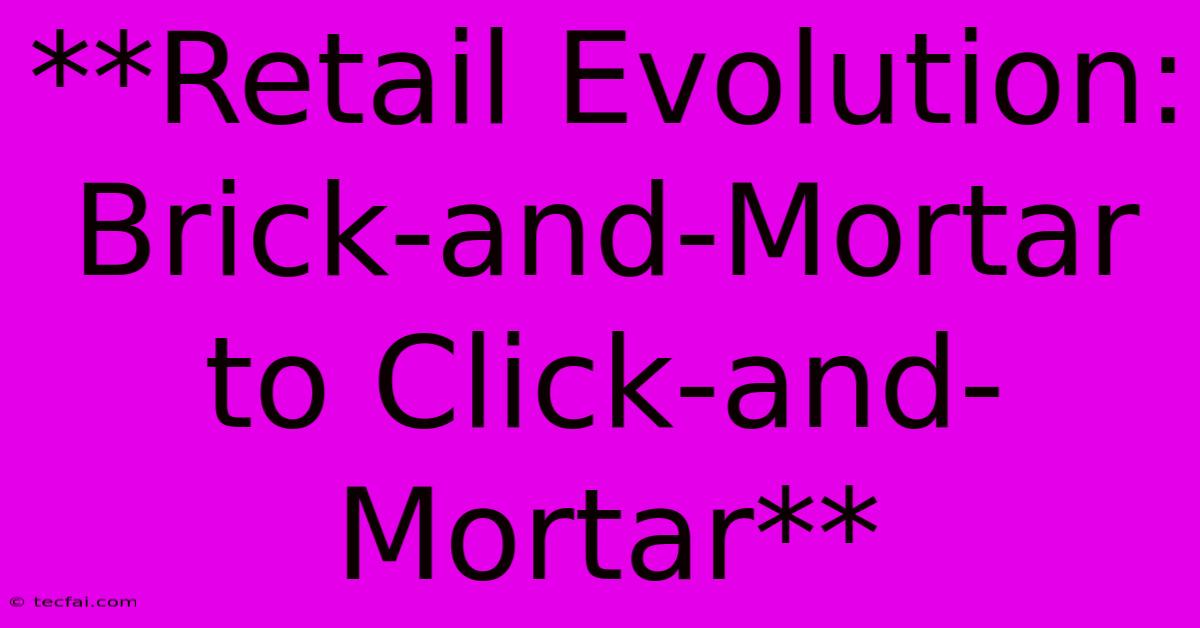**Retail Evolution: Brick-and-Mortar To Click-and-Mortar**

Discover more detailed and exciting information on our website. Click the link below to start your adventure: Visit Best Website tecfai.com. Don't miss out!
Table of Contents
Retail Evolution: Brick-and-Mortar to Click-and-Mortar
The retail landscape is in a constant state of flux, driven by evolving consumer preferences and technological advancements. One of the most significant transformations in recent years has been the shift from traditional brick-and-mortar stores to a hybrid model known as click-and-mortar. This evolution has fundamentally changed the way businesses operate and consumers shop, creating a new era of retail experiences.
The Rise of Click-and-Mortar
For decades, brick-and-mortar stores were the dominant force in retail. Consumers relied on these physical locations for product discovery, interaction, and purchase. However, the advent of the internet and e-commerce began to challenge this paradigm. Online retailers offered convenience, wider selection, and competitive pricing, attracting a growing segment of shoppers.
Click-and-mortar retailers emerged as a response to this changing landscape. These businesses embraced the power of online platforms while retaining the value of physical stores. They leverage the best of both worlds, offering:
- Online Shopping: Customers can browse, research, and purchase products from the comfort of their homes.
- Physical Stores: Customers can experience products firsthand, get personalized advice from staff, and enjoy immediate gratification.
Key Elements of a Successful Click-and-Mortar Strategy
Building a thriving click-and-mortar business requires a strategic approach that seamlessly integrates online and offline experiences. Here are some key elements to consider:
1. Omnichannel Integration: A seamless omnichannel experience is paramount. This means providing a unified customer journey across all touchpoints, including online, mobile, social media, and physical stores.
2. Enhanced Customer Service: Click-and-mortar retailers have the unique advantage of offering both online and in-person customer service. Utilizing both channels effectively can create a highly personalized and responsive experience.
3. Data-Driven Insights: By leveraging data from online interactions, store analytics, and customer feedback, businesses can gain valuable insights into consumer behavior. This data can inform marketing campaigns, product selection, and store layout optimization.
4. Fulfillment Flexibility: Click-and-mortar retailers can offer multiple fulfillment options, such as buy online, pick up in-store (BOPIS), ship-from-store, and curbside pickup. Providing a range of choices caters to diverse customer preferences and needs.
5. Engaging In-Store Experiences: Physical stores can be transformed into destinations for immersive and interactive experiences. Retailers can utilize technology like augmented reality, digital displays, and personalized recommendations to create memorable and engaging environments.
The Future of Retail
The click-and-mortar model is not just a temporary trend; it is a fundamental shift in the retail landscape. Businesses that embrace this approach are best positioned to thrive in a rapidly evolving market.
Key Trends Shaping the Future of Click-and-Mortar:
- Personalized Shopping Experiences: Utilizing data and technology to create customized recommendations and offers for each customer.
- Increased Use of Technology: Integration of augmented reality, virtual reality, and artificial intelligence to enhance the shopping experience.
- Focus on Sustainability: Sustainable packaging, reduced waste, and responsible sourcing becoming increasingly important to environmentally conscious consumers.
As technology continues to advance, the lines between online and offline shopping will blur even further. Click-and-mortar retailers will need to adapt and innovate to remain competitive in a dynamic and rapidly changing retail landscape.

Thank you for visiting our website wich cover about **Retail Evolution: Brick-and-Mortar To Click-and-Mortar**. We hope the information provided has been useful to you. Feel free to contact us if you have any questions or need further assistance. See you next time and dont miss to bookmark.
Featured Posts
-
Parsons Mc Carthy Address Edge Rush Concerns
Nov 12, 2024
-
Referee Coote Faces Suspension For Klopp Abuse
Nov 12, 2024
-
Veterans Day Business Hours Banks Usps Fed Ex Ups
Nov 12, 2024
-
Tesla Stock Rises After Election Musk Gets 68 B
Nov 12, 2024
-
Who Plays Monday Night Football Week 9
Nov 12, 2024
